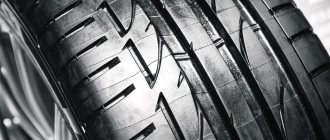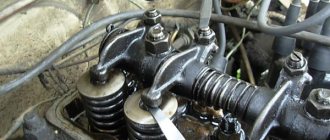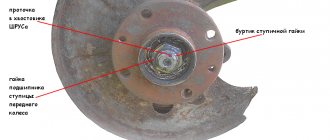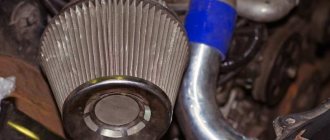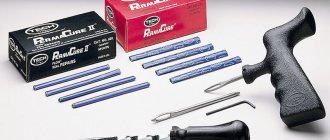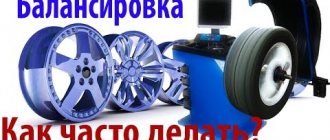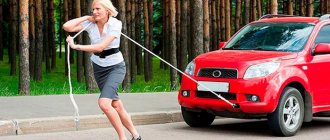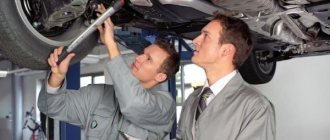Published: 01/28/2021
- Causes of wheel imbalance
- Balancing Features
- What is wheel balancing?
- Correct wheel balancing
- Approximate cost of wheel balancing
- Commentary on ticket No. 14 (18)
- Myth: Vulcanizations ruin tires so they can be returned to them
- Balancing your wheels yourself
- Is it necessary to do balancing when changing wheels on rims?
- Some tips for improving wheel balancing
- How to do wheel balancing
- How is wheel balancing done?
- All stages of the process
Causes of wheel imbalance
The appearance of imbalance is possible during normal operation of the vehicle, but it is usually preceded by the following events:
- getting the wheel into a significant hole, or driving along a road with a lot of potholes;
- hitting the curb with wheels, for example, when parking poorly;
- changing tires due to seasonality or wear of old tires;
- a large amount of dirt on the wheels, for example, after leaving the city;
- tuning a car with low-quality plastic caps with disturbed weight distribution;
- shrinkage processes that occur after running in a new tire;
- restoration operations were performed on the disc;
- There was a tire puncture.
Important Balancing Information
When balancing wheels, certain rules must be followed. If you ignore them, the result will noticeably worsen.
- It is necessary to remove lead weights from the rim of the disc;
- The disk is cleaned of dirt;
- It is checked how well the tire is installed on the rim;
- If there are plastic caps on the wheels, the wheel balancing is disrupted.
You can often hear the opinion from car enthusiasts that balancing does not require special attention, and the quality of car operation does not depend on it in any way. If balancing is incorrect, you may encounter the following problems:
- Tires wear unevenly;
- Individual suspension elements are subject to accelerated wear;
- The vehicle's handling is noticeably reduced;
- You can feel the steering wheel beating;
- When driving, the car may pull to the side;
- The braking distance increases noticeably;
- Road grip is reduced;
- The body begins to vibrate;
- The degree of comfort when using the car is noticeably reduced;
- Car costs increase significantly.
Balancing Features
First of all, before performing this work, it is necessary to clean the wheel from any dirt adhering to it and remove dust from it. If there are pieces of ice or stones in the tire tread, they must also be removed. Old weights are also removed, and if a “forgetful” or unqualified tire fitter did not do this, then you should remind him of this need.
After the wheel is mounted on the stand, it is necessary to carry out preliminary measurements of the tire runout in the lateral and radial directions. This is done for comparison with the results obtained at the end of the procedure.
To ensure a good fit of the tire on the wheel rim, a special lubricant is used. If for some reason this is not done, then there is a high probability of mounting the tire on the wheel with a slight misalignment, after which it becomes impossible to completely balance the wheel. An incorrect fit cannot be determined visually from the outside. If the wheel does not balance, increase the pressure in the tire and tap it around the perimeter of the rim.
Some service stations have new balancing machines in their arsenal of modern equipment, which motorists call “3D tire fitting”. Using a laser, the geometry of both the tire itself and the disk is accurately measured. The magnitude of the beats is measured in three coordinates.
This equipment almost ideally carries out the installation of the tire on the disk, because it takes into account the individual defects of each of these two components and compensates for them mutually. A 3D stand is very expensive, and it requires special qualifications to operate it. You will not find such equipment at a small service station; it is only available at large stations in big cities - a large flow of customers allows you to quickly overcome its high cost.
Do I need to balance wheels if I don't change rims?
How to determine brake disc wear
When wondering how often wheel balancing should be done, many people wonder whether it needs to be done at all when driving on the same rims. The answer will be clear: when changing tires every season from summer to winter and back, such an operation is necessary. But is it worth balancing the wheels if you change a complete set of wheels every season?
First of all, you should refer to the included vehicle instructions. As a rule, it recommends balancing after reaching 10,000-15,000 km. If less distance is traveled in one season, then there is no need to perform balancing, except for some cases described below.
But it’s one thing to follow the instructions, and another thing to watch the actual behavior of the car. Namely, it is worth monitoring the steering wheel beat. If it is not there, there is no need to balance the rims. The rear axle's runout is reflected less strongly on the steering wheel, although it suffers less frequently than the front axle. However, a significant imbalance will be noticeable in any case.
When replacing wheels yourself, it is recommended to do the following twice a year. You need to drive on new tires for a couple of days - during this time, deformations in the tires that occurred during storage will be eliminated. If there are no vibrations during driving at all speeds used, balancing does not need to be done.
The need for balancing arises in the following situations:
- mileage during the season exceeded 15,000 km;
- after another balancing, the car drove with the same wheel over a deep pothole at high speed;
- in the previous season, vibration was noted, but balancing was not carried out;
- The car does not have an ABS system, and skidding braking on asphalt is often used;
- The car is driven by a novice driver who is not yet able to sense wheel imbalance.
What is wheel balancing?
Wheel balancing is the procedure for preventing imbalance between wheels, rims, hubs, suspension parts and fasteners. The need for periodic operation is due to centrifugal force.
During the balancing process, the mass of the wheel is located evenly relative to its center. When the procedure is performed correctly, vibration during vehicle operation is reduced and the service life of bearings and car tires is increased.
Benefits of wheel balancing:
- Comfortable ride on roads of any type and quality.
- No unnecessary noise from car wheels.
- Increased wheel usage.
- Ease of driving at various speeds.
- Car tires wear out equally and evenly on all sides.
Wheel balancing is required for any car, regardless of the condition of the wheels, tires or the newness of the model.
Consequences of not balancing wheels:
- Frequent bearing failures.
- Steering wheel vibration during vehicle operation.
- Early and uneven wear of car tires.
- Noise in the cabin.
- Immediate shock absorber failure.
- Unsafe movement due to each wheel acquiring its own centrifugal force.
- In advanced cases, the vibration of the wheels causes the bolts to become unscrewed and the ball joint to fly out or fall off.
How often should your car wheels be balanced?
Most often, the question of how often a car's wheels need to be balanced also arises for beginners. There are no clear standards for when to balance or after what mileage. But experienced drivers still make some suggestions when it is worth balancing car wheels.
The first and most important rule is that every time you change tires, whether they are new or used, the car’s wheels are balanced in order to equalize the centrifugal force, since changing wheels or tires shifts the center of traction. In terms of mileage, it is recommended to carry out balancing after every 5,000 kilometers of a vehicle running on the same wheels.
In case of suspension repairs or frequent driving on bad roads (hitting potholes), it is worth balancing the wheels more often than 5000 kilometers; it is usually recommended after 1000-1500 kilometers. If vibration occurs in the body, in the cabin, on the gearshift lever or steering wheel, often at speeds of 60 km/h and above, balancing should not be postponed.
The conclusion is quite simple, car wheels need to be balanced every time you change shoes or tires, plus, given the condition of the roads, wheel balancing needs to be done more often.
Correct wheel balancing
The highest quality balancing is guaranteed by following a number of rules:
- The disc must be cleaned of any dirt. Quite often there is a lot of it, not only on the inside, but also on the outside. Automation calculates how much cargo needs to be hung in one or another part of the wheel. If you balance a dirty wheel, then you risk losing all balance on the first bump, after lumps of dirt fall off your disk;
- It is recommended to remove all old balancing weights;
- Quite often there are situations when the tire does not completely fall into place. It is not always possible to notice this from the outside, but this can have a rather strong effect on the balancing;
- Plastic caps, which are often put on immediately after the balancing procedure, can also significantly increase the imbalance in newly balanced wheels.
What is the risk of steering wheel beating due to improper balancing?
Steering wheel wobble if the wheels are not balanced correctly can lead to quite sad consequences: - you can forget about good handling and driving safety - the steering will gradually break down - the shock absorbers will fail - you will have to change the step bearings and other suspension parts. All this happens as a result of vibration spreading throughout the body due to wheel imbalance. It should be noted that steering wheel wobble can be caused by both poor balancing and defects in the disc and tires (damage to the cord, hernia, etc.). But we can say with almost absolute certainty that if the steering wheel wobbles at high speeds, the reason is an imbalance of the front wheel, and the car’s drive does not matter at all. Rear wheel imbalance is usually not displayed on the steering wheel.
Most often, the problem of steering wheel runout occurs after a seasonal tire change.
Many drivers do not pay any attention to how and on what equipment the wheel balancing procedure is carried out.
And this is very important. For example, the result of balancing can be reduced to zero after 200-300 km, if the tire shop did not wash the wheel well during balancing - the dirt will fall off and the wheel will again be unbalanced
Often the problem of steering wheel beating occurs due to the fact that a low-quality weight is installed. As a result, when exposed to centrifugal force, it will simply come off and the steering wheel will immediately manifest itself.
For example, the result of balancing can be reduced to zero after 200-300 km, if the tire shop did not wash the wheel well during balancing - the dirt will fall off and the wheel will again be unbalanced. Often the problem of steering wheel beating occurs due to the fact that a low-quality weight is installed. As a result, when exposed to centrifugal force, it will simply come off and the beating of the steering wheel will immediately manifest itself.
When assembling wheels, correct, high-precision balancing is a guarantee that you will be spared the problem of steering wheel beating and its unfortunate consequences
That is why special attention should be paid to such a seemingly simple procedure as wheel balancing. It is not particularly expensive, and saving on it is simply not advisable, since as a result of poor-quality, incorrect wheel balancing and, as a result, steering wheel beating, you will have to spend money on expensive repairs
Correct wheel balancing: how to recognize?
The wheel must have weights installed on both the internal and external sides. If it is impossible or does not want to install them during the disc phase, the weight is installed as close as possible to the outside (near the spokes) from the inside. Balancing with one weight is also possible, but due to its complexity it is rarely used. The weight to be hung (weights) should not exceed 60 grams on the wheel (new) and be located nearby. If the weight is greater, then the reason may be improper assembly of the wheel, as well as if the disk has defects (bent) or a packed tire.
The wheel balancing procedure is a recent one. Drivers neglect it because they do not know all the intricacies and advantages of the operation, remembering it only when the steering wheel begins to tremble and vibrate with every turn. The article talks about wheel balancing, what it is and why it needs to be done.
Approximate cost of wheel balancing
The cost depends on the prices of the selected car service or a specific tire shop. Usually balancing is done for relatively little money. The cost is primarily affected by the diameter of the wheel - the larger it is, the more expensive the procedure will be.
In addition, the type of wheel used matters. Balancing a steel disc is usually less expensive than correcting an imbalance in an aluminum disc. Finally, the final cost of the procedure takes into account the type of weights used.
In most tire shops, balancing is done as part of the seasonal tire replacement work.
Currently, the average cost of balancing one wheel with a diameter of 15 inches with a steel disk in Russia is 170 rubles. Accordingly, the total cost for all four discs will be 680 rubles.
These are average prices. There are both small garage-type workshops that offer this service cheaper, and premium services, where the cost of such an operation can be even higher than that of official dealers.
It is worth considering that the indicated prices do not include the wheel replacement service. Therefore, to get the full picture, you need to make an adjustment, adding about 50-100 rubles to the cost for each 15-inch wheel.
Reasons for mandatory work
It is imperative to check and perform balancing in the following cases:
- when transferring the car to summer and winter operating modes (seasonal tire replacement);
- after sharp impacts on the wheel when falling into a hole or hatch, hitting a curb, speed bump at high speed, etc.;
- mandatory balancing every 15,000 km (manufacturers' requirement);
- before planning a long trip to regions where there are no service stations;
- If you have an aggressive driving style, it is recommended to carry out work every 7-8 thousand km. Remember that wheels are one of the factors for your safety and the safety of other road users.
Myth: Vulcanizations ruin tires so they can be returned to them
Not a single normal tire shop, and especially during the re-shoe season, wants the client to return with a flat tire. This is extra work for which you don't get paid. And the schedule during this period is tight - there are queues. Why else would they need all this trouble? But there are situations when, when beading a wheel, the sealing compound is applied unsuccessfully (the very moment when the tire is lubricated with a special paste or, in extreme cases, with oil or soap). In this case, the tire may go flat overnight, especially if the driver immediately after changing shoes put on a load, deciding to drift in the fresh snow.
And yet we should not forget about the crookedness of some hard workers. These can inadvertently cut the rubber, and often damage the rims, especially when working with low-profile tires. Unfortunately, the market for these services does not imply professional education; there are many amateurs here, and even a schoolboy can become a tire fitter.
Reviews
Motorists' opinions on the procedure.
I do balancing twice a season and every time I change tires. Some people shout that there is no need to partake like that and then they perform magic on the pendant.
There has been a homemade machine at home since Soviet times. I balance it for myself and my neighbors in the garage, the accuracy is normal, no one has complained.
Specialization : Graduated from the State Automobile University, worked for 20 years at GAZ-56, now I drive a Zhiguli.
Source
Balancing your wheels yourself
Now let's look at the question of how to balance wheels on your own.
The most important thing is to take your time! Rushing may have a negative impact on the final result, and then you will still have to go to a technical service point.
First stage: preparatory. When preparing for the balancing procedure, you need to buy special self-adhesive weights. These weights will serve as balancers located on the disk itself. Their main task is to maintain balance.
The wheels themselves must be clean and cannot contain any small objects, such as stones. The dirt must be completely removed from the tires. Be sure to remove the cap, if present. Then take a jack and use it to lift one side of the car, freeing 2 wheels. Check the free rotation of the wheels.
Second stage: we determine the heaviest point of the wheel. To this end, we do the following:
- Turn the wheel clockwise until it stops. When you reach the stop, mark the lowest point. To do this, we put a mark with a special bright marker.
- Turn the wheel counterclockwise. In the case when, upon reaching the stop, the mark is again at the very bottom, we have found the heaviest point.
- After this, we proceed to balance the opposite wheel. Place weights on both sides of the disc rim.
- Spin the wheel and add weights until the wheel marked with a dot stops in different positions.
These four stages must be carried out on each wheel. And to be sure that you did everything correctly, you need to drive a vehicle for two or three km. If you did something wrong, you will feel vibration in the steering wheel.
What consequences can occur if balancing is performed incorrectly?
Incorrect or untimely balancing can lead to many adverse consequences. And it’s good if you just feel vibration in the steering wheel, or discomfort while driving. In the most advanced cases, this can lead to very unpleasant and even dangerous consequences.
- This is not safe as the braking distance increases. The car becomes more difficult to control. As a result, this can lead to emergency situations.
- It becomes more difficult to control the vehicle. There is a beating of the steering wheel, which not only distracts the driver, but also makes it difficult to control. The load on the suspension increases.
- The service life is reduced, and individual parts may even collapse.
- The rubber wears out. Rubber deteriorates unevenly, which leads to imbalance. Most often, wear occurs on the outside and inside of the wheel.
What wheel imbalances can there be?
There are two types of wheel imbalance on your vehicle. The first one is dynamic. It occurs when the weight of the wheels begins to fluctuate while driving. The wheel begins to move from side to side. The dynamic type of imbalance develops when the weight is shifted to one side of the wheel centerline.
Second type: statistical. This type develops when the wheel has an excessively heavy or light section. The wheels begin to oscillate up and down.
I would like to say that balancing wheels on your own is not particularly difficult; if you do it several times, you will acquire the necessary skills and will do it perfectly.
However, for the very first time, it is better to watch thematic videos that can be found in large quantities on the Internet.
Another tip: after the first time, check the correctness of the procedure at service stations.
If you want to be one hundred percent confident in the safety of the procedure performed with your own hands, the final balancing can be performed at the same service station, but using specialized equipment.
And one more recommendation: to achieve the best result, before starting the procedure, check the relative position of the disk and tires. Very often, the tires are misaligned relative to the rim of the disc, which causes an imbalance. This often happens after repairing and dismantling a tire or tube.
And in conclusion, we consider it necessary to repeat once again that the safety on the road, your own life and the health of your family members depend on how well you carry out self-balancing of the wheels of your vehicle. Balancing should be carried out regularly, or even better, create your own car maintenance schedule, which includes this procedure.
Is balancing necessary every season when replacing wheel assemblies?
When changing tires seasonally, some drivers balance the wheels, believing that this procedure eliminates steering wheel wobble or suspension problems. Other motorists, on the contrary, believe that when replacing wheel assemblies it is not at all necessary to carry out balancing, and the need for it is simply explained by the desire of service shops to earn more money.
The benefits of wheel balancing. Wheel balancing is a useful procedure that allows you to align the center axis of the wheel with respect to both sides. To do this, small weights are hung on the disks. As a result, the driver receives several advantages:
- Improves vehicle handling
- Eliminates the possibility of steering wheel beating
- Knocks in the suspension are prevented
- The trip becomes more comfortable
Most masters consider the balancing procedure necessary, because without it, at speed you will feel discomfort due to the beating of the steering wheel, subsequently the suspension will fall apart, and the car will be difficult to control. It is unlikely that any master will voluntarily refuse to carry out the balancing procedure, because this is a good additional income for him.
Most showrooms offer wheel balancing using special equipment; it helps determine wheel deviations and eliminate them. By placing small weights on the rims, the craftsmen achieve the ideal position of the wheel; the owner can be sure that the wheel will not spin out at speed or fall off while driving, and the suspension will last much longer.
Problems with wheel balancing. Despite the benefits, wheel balancing is not a repair solution to solve all problems. In addition, it should be borne in mind that the quality of the procedure largely depends on the experience of the master. It happens that motorists immediately after balancing go to another workshop, carry out a second check and it turns out that the wheels are unbalanced and require urgent balancing.
In this case, most likely, low-quality equipment was used. As a result, drivers pay twice and wonder why they should carry out balancing at all if they do it poorly. Not very large service stations, as a rule, use cheaper equipment; moreover, it can be adjusted instead of replaced, which also leaves a mark.
To avoid problems, it is best to carry out balancing in a center where masters use modern equipment and constantly test and improve it. This way you can be sure that the procedure will be carried out correctly and efficiently. It’s still not worth giving up balancing completely, since the safety of the driver and passengers on the road directly depends on it.
Bottom line. Although many motorists consider wheel balancing to be a completely optional procedure, you should not refuse it. It would be better to contact a specialized tire center, where they only balance wheels, use the most modern equipment, test and constantly improve.
It is worth remembering that not only driving comfort, but also the safety of passengers and the driver depends on the position of the wheel rims.
Is it necessary to do balancing when changing wheels on rims?
When replacing tires on cast or stamped wheels, balancing is required. This is justified by the disturbed weight distribution of the tire and disk itself. When leaving the assembly line, products have errors that can disrupt the ideal symmetry of the axis of rotation. The consequence of the effect is rapid wear of the chassis and vibration on the body or steering wheel. If the tire is not beaded, the procedure is not necessary, but recommended. During operation, the weights may become dislodged, and the possibility of the tire itself rotating is also not ignored. Thus, tires must be serviced every time the wheels are handled.
Is it necessary to have wheels balanced every season?
When installing a replacement set of tires or wheel assemblies after storage, rebalancing is critical. This requirement is especially relevant when changing tires on one set of wheels. Each slope has its own weight distribution. For example, a winter studded model will differ significantly from the summer version. If it is installed in place of an old tire, the weights will be placed in the wrong places, causing severe shaking or vibration.
Thus, the annual transfer from winter to summer and vice versa is accompanied by the mandatory delivery of wheels to a special machine.
Do new tires need balancing?
Each tire leaves the factory with balance flaws. At the same time, models from trusted brands may have a greater error than budget-type options. When such a tire is placed on a wheel rim, the disproportionality is transferred to the product assembly, which guarantees runout in the suspension or vibration of the steering mechanism. Experienced motorists, when purchasing a new set of tires, are required to balance all wheels. In this case, old weights or marks are completely removed from the rims.
Does it make sense to balance the rear wheels?
Correct weight distribution of the ramps or discs is a prerequisite for adequate suspension performance. Improperly balanced wheels greatly damage the car, regardless of the axis of location.
Thus, the procedure must be performed for all four tires installed on the car.
Is balancing necessary when switching to winter tires?
Regardless of the operating options, the answer here is clear: yes, balancing is needed.
Consider the option with two sets of tires on rims.
Having left the winter, the driver sends the winter kit for storage in the garage or on the balcony. The wheels will return to the car only closer to the next first snow. During its operation, the wheel most likely flew into a hole more than once; perhaps the tire was inflated untimely, or was used in modes not intended for it. All this can lead to the loss of weights, a slight change in the weight distribution of the tire, but sufficient to upset the balance of the wheel.
Tire manufacturers recommend balancing every 10-15 thousand km. Each driver has his own driving regime, so these recommendations are quite difficult to follow. It is best to carry out checks and balances before the start of the season.
Regarding winter studded tires, there is a special opinion that the mileage until the next inspection is 5 thousand km. The reason is flying spikes and increased loads on the wheel, which are formed due to adhered ice.
It is also recommended to balance after a puncture or cut has been repaired, or after a serious impact.
What affects the quality of balancing
The quality of work is influenced primarily by equipment. Both the level of the stand and its wear are important here.
The best results are achieved by computer-controlled stands.
Such equipment allows you to balance disks using a system of spaced weights, even for wheels with large unbalances.
Stands can be calibrated to different accuracies: 1, 5, 10 grams. The most commonly used is 5-gram accuracy. This is quite enough to achieve good results for a wide range of car tires.
10 grams does not provide such accuracy, but for lack of anything better, it is quite sufficient. Calibration of the machine by 1 gram is necessary for vehicles operated at high speed limits.
However, no matter how modern the equipment is, elements wear out over time. Most often, the wheel fastenings are worn out, which introduces errors in balancing. The bearings of the stand become unusable less often. When a bearing is damaged, there is beating in the bearing itself. This situation leads to inadequate sensor readings and imbalance.
Some tips for improving wheel balancing
To check the accuracy of the tire mounting procedure, after it has been carried out, you can remove the wheel from the balancing stand and then put it back on. Repeated diagnostics will certainly show the presence of an imbalance. For wheels made using light alloy casting technology, a discrepancy of 3 grams per side is acceptable. In the case of steel stamping, the plus or minus can reach five grams.
Some tire centers have special installations that help with “finishing” balancing. It is in no way an alternative to the procedure carried out on classic stands, but serves as an important addition with which you can determine the static imbalance of not only the wheel, but also the entire assembly consisting of wheels, hub and brake disc. The maximum weight of weights used during “finishing” balancing should not exceed 15 grams.
How to do wheel balancing
Wheel balancing machine
Before submitting the wheel to a computer stand for balancing, it is advisable to thoroughly wash and clean the tread and disc from dirt, small stones and sand. Their presence will not allow you to carry out the procedure correctly, and you will not get the expected result. Also, before starting balancing, the master must remove all previously installed balancing weights, regardless of their location.
Both front and rear wheels need to be regularly balanced. You should not single out only the leading pair, hoping that the mechanical impact on the other two wheels is less. Uneven wear can appear on any of the four treads, which will entail the consequences already described above.
The wheel balancing procedure itself is carried out on a special balancing machine or stand. The principle of its operation is to install a wheel on a rotating cone, which is automatically controlled by a computer program. The latter determines the exact type of imbalance and indicates where it is necessary to install a special weight to level the center of gravity.
The average weight of a zinc or lead load ranges from five to sixty grams, and is set manually by the master. The specialist also selects a balancing weight option (adhesive or padded), which is used in accordance with the type of wheel rim.
A modern method of computer diagnostics and balancing allows us to identify the slightest aspects of axial displacement that are invisible to the human eye. And it makes it possible to optimally correct the existing situation, which negatively affects the overall technical condition of the car.
Why do you need to balance car wheels?
A completely fair and logical question. It would seem that you “put on” tires and drive a car for your own pleasure. In fact, not everything is as simple as it seems to many. Balancing a car wheel is an important procedure that directly affects traffic safety.
The procedure for balancing car wheels is performed in the following cases:
1. Replacing summer tires with winter tires or in reverse order. The rims remain the same, but the tires change. Driving on summer tires in winter is prohibited by law in many countries around the world.
This will definitely interest you Caring for a leather car interior
2.Frequently falling into a hole or hitting other obstacles can lead to wheel imbalance. Often the force of the impact turns out to be so impressive that the discs have to be replaced due to their damage.
3. Experts recommend balancing vehicle wheels after 20 thousand kilometers. The car does not always move on a well-maintained road surface. The presence of holes, potholes and other road surface defects negatively affects wheel balancing.
4. If the rubber surface is damaged, it is dismantled and repaired. It is necessary to balance the wheels after such intervention.
5.Long trips over distances of more than 2 thousand kilometers require a mandatory wheel balancing check for safety reasons.
How is wheel balancing done?
Before you begin balancing, the wheel should be prepared. First, it is thoroughly cleaned, all old weights are removed, washed, and dried. Check that the tire is installed correctly. The wheel should be slightly lowered, the air pressure in it should not exceed 0.2–0.3 kgf/cm2.
At tire shops, balancing is carried out using special balancing stands or machines. But you can try to eliminate the imbalance at home without a stand, however, the accuracy of such a procedure will be much lower.
In order to eliminate the imbalance at home, you need to lift the car using a jack so that the wheel rotates freely. First it spins to the right. After stopping, a chalk mark is placed at the highest point. Then it spins to the left, the procedure is repeated. The distance between the marks must be divided in half and a new mark must be placed. After this, special weights with spring clamps are installed on both sides of the mark on the tires for balancing, which are mounted under the tire, while the weights are held on the wheel rim. Then the wheel is spun again by hand. If after stopping the weight occupies the lower position, then everything is fine, its weight is sufficient. If it ends up at the top, then you should replace it with a heavier one. By moving the weights to the same distance from the mark, it is necessary to ensure that after unwinding, each time the tire stops in a new position, chaotically. If this can be done, then the wheel is pumped up and you can start balancing the other one. The imbalance on the front wheels is corrected at their hubs. But the rear ones should be unscrewed and moved to one of the front hubs for balancing.
At service stations and tire shops, this procedure is carried out using special equipment. After all the preparatory procedures, the wheel is installed on a balancing machine with a fastening cone.
Correct wheel balancing, the most accurate, is done on a special computer stand. A wheel is installed on it and its parameters are set. After that, spinning it in different directions, using a computer, the lightest place and the missing weight are revealed. The car service specialist simply adds weights to the disc in the required places to eliminate the imbalance.
It is worth considering that the total weight of the installed weights should not exceed 60 grams. If their total weight is higher, it is worth thinking about whether the wheel is assembled correctly, whether the disk is deformed, or whether the tire is stale. If the tire is just from the store, and is installed correctly, there is no damage to the disk, then the need to attach weights with a total weight of more than 60 grams. indicates her marriage and may serve as a reason to return to the store.
After the usual, some tire centers perform final wheel balancing. It is carried out after installing the tire on the car, since here the imbalance of the wheel is checked and eliminated simultaneously with the hub and brake disc. To do this, the wheel is spun and by using a final balancing device, the imbalance of the entire assembly is revealed. It is leveled using the same weights. Moreover, their weight should not be more than 15 grams
It is important to understand that this is not an alternative to computer stands or machines, it is simply a way to improve the quality of balancing
Should new tires be balanced?
The balancing procedure must be carried out after mounting new tires. This is due to the remote location of the tire relative to the axis of rotation of the disk. During installation, the lightest point on the tire is aligned with the heaviest point on the rim (in the valve area).
Performing wheel balancing
The imbalance after installing a new tire can reach up to 50-60 grams, and to balance it to zero you will need to stick a large number of weights on the outer and inner parts of the rim. This is not always acceptable in terms of aesthetics, since a large number of weights spoil the appearance of the wheel. Therefore, before balancing, it is advisable to perform optimization: spin the tire on the rim so that both mass points coincide.
All stages of the process
At service stations and tire fitting stations, technicians eliminate defects of unevenly divided mass using compensating weights in certain places. The process is performed on special equipment.
The equipment automatically determines the place where the weight needs to be installed. The wheel dimensions are entered into the computer. The equipment will then select the optimal point for additional cargo. This is static balancing.
What type of weight to use depends on the disk and its parameters. This can be zinc or lead weight. They differ in weight - usually the weight ranges from 5 to 100 grams.
There is also dynamic balancing, however, this service is not provided everywhere. The problem is the equipment - in most cases it is very old. The wider the wheel, the greater the chance that dynamic imbalance will appear.
Final balancing is performed after static and, if possible, after dynamic. When the car is suspended, special equipment is installed under the wheels, the wheels are spun to high speeds, the system takes measurements and marks the places where the load should be installed. The system also calculates the weight of the load itself.
This process requires serious equipment, available only in professional wheel centers.
There is also automatic balancing, but it is not for cars, but for trucks. The master pours a special granule, beads, and sand into the wheel. During movement, due to centrifugal force, the material is attracted to the tire inside. The result is self-balancing. It is a pity that the technology is not available for passenger cars.
Equipment
There are different types of equipment – stationary and mobile. Stationary machines can determine the amount of imbalance of only the dismantled wheel. These machines can be electrically or manually driven.
On the first models, the disk rotates due to an electric motor. In the second case, you need to turn it manually
It doesn't matter what makes the disk spin - it doesn't affect the accuracy one bit
Simple models of machines work with steel disks and several types of cast ones. More complex equipment can work with disks of any design without problems. The program itself is capable of placing a weight at any point.
The electronic part of serious stands is capable of performing a lot of useful functions. For example, it can divide large loads into many small ones and distribute them to different points. This mode is effective if the imbalance is huge.
In this case, the stand shows several points. Another useful feature is optimization. The electronics analyze the imbalance of the tire and wheel, then find the optimal position relative to each other, thereby ensuring maximum balance. Using this function, you can reduce the amount of weight on the disk.
Mobile equipment is rolling stands for cars. They can be used for balancing without removing the wheels. The advantages are that the stand also takes into account other rotating masses - these could be hubs, brake discs or drums. Most often, such stands are used for finishing work after a stationary stand.
How to do balancing correctly
The wheel is thoroughly cleaned and then installed on the machine. Next, the equipment calculates the weight of the weights and the mounting points.
The mechanic installs the weight and checks the balance. If all indicators are normal, then the wheel is installed on the car. If there is no balance, then the process continues further.
Errors
There are a number of rules that must be followed:
- The disk must be thoroughly cleaned. There is usually a lot of dirt on the outside and on the inside. Automation calculates the weight of the weights. If you work with a dirty disk, you can lose your balance already on the first bump, when large dirt falls off the disk;
- Be sure to remove all old weights;
- It often happens that the tire simply does not fit into place. This is not visible from the outside, but it affects the balancing process;
- Hubcaps and other accessories can add imbalance.
These mistakes are often made at tire shops, because they work not on quality, but on volume and speed.
Is it possible to balance the wheels yourself?
Now that we have figured out what wheel balancing is, why this procedure is needed and how it is performed in special services, it’s time to talk about whether it can be done independently.
Nothing is impossible, especially if the situation does not allow you to contact a tire shop. Of course, it will not be possible to achieve high balance indicators without special equipment, but it is quite possible to roughly adjust it.
Do-it-yourself wheel balancing is carried out using the same weights that are used in the service. And preference here should be given to printed ones. They are freely sold in any auto store or car market.
The only tools you will need are a jack, a wrench to unscrew the hub nut, and a small hammer. Do-it-yourself wheel balancing involves carrying out all activities without removing the wheel from the hub.
Using a jack, we lift one side of the car where the wheel with suspected imbalance is located. We turn off the gear if this wheel is one of the drive wheels. Undo the cotter pin and slightly loosen the hub mounting nut.
Next, carefully inspect the tire for adhered dirt or stones stuck in the tread. All this needs to be removed. If there are old weights on the disk, they also need to be removed.
It is advisable that the tire pressure corresponds to the recommended value.
Spin the wheel counterclockwise and wait until it stops. We mark its top point with chalk. Now rotate the wheel to the right and mark the top position again. Between these marks is the easiest part of the wheel. Opposite each mark, use a hammer to place weights weighing 30 g.
Next, turn the wheel in any direction. After stopping, the weights should be at the bottom. This is the lowest balancing point. Now we turn the wheel and shift the weights, moving them apart from each other until the wheel stops in different positions. We perform the same procedure with other wheels.
Do-it-yourself wheel balancing
Hello, dear readers and visitors of the Avtogid.ru blog. Today in the article you will learn how to balance car wheels with your own hands. Of course, you can object and say that why carry out the steps to balance the wheels of your car yourself if you can contact a tire shop. These objections are partly correct, but if you look at it on the other hand, you always want to learn more new, interesting and useful information.
It’s nice to complete any actions on your own without involving outside help. Do-it-yourself wheel balancing, among other things, is an excellent opportunity to save on vehicle operation. In principle, if you take everything apart in detail, it won’t take much time to balance your car’s wheels. The most important thing is to overcome your own laziness and fatigue. Therefore, you should not balance wheels on weekdays after work, the efficiency will be zero and the quality will suffer first of all. It is better to choose a day off for this and calmly complete the work without haste or hassle.
